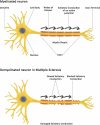Temperature sensitivity in multiple sclerosis: An overview of its impact on sensory and cognitive symptoms
- PMID: 30377640
- PMCID: PMC6205043
- DOI: 10.1080/23328940.2018.1475831
Temperature sensitivity in multiple sclerosis: An overview of its impact on sensory and cognitive symptoms
Abstract
Multiple sclerosis (MS) is an autoimmune neurodegenerative disease characterized by demyelination of the central nervous system (CNS). The exact cause of MS is still unknown; yet its incidence and prevalence rates are growing worldwide, making MS a significant public health challenge. The heterogeneous distribution of demyelination within and between MS patients translates in a complex and varied array of autonomic, motor, sensory and cognitive symptoms. Yet a unique aspect of MS is the highly prevalent (60-80%) temperature sensitivity of its sufferers, where neurological symptoms are temporarily exacerbated by environmental- or exercise-induced increases (or decreases) in body temperature. MS temperature sensitivity is primarily driven by temperature-dependent slowing or blocking of neural conduction within the CNS due to changes in internal (core) temperature; yet changes in skin temperature could also contribute to symptom exacerbation (e.g. during sunlight and warm ambient exposure). The impact of temperature sensitivity, and particularly of increases in core temperature, on autonomic (e.g. thermoregulatory/cardiovascular function) and motor symptoms (e.g. fatigue) is well described. However, less attention has been given to how increases (and decreases) in core and skin temperature affect sensory and cognitive symptoms. Furthermore, it remains uncertain whether changes in skin temperature alone could also trigger worsening of symptoms. Here we review the impact of temperature sensitivity on MS sensory and cognitive function and discuss additional factors (e.g. changes in skin temperature) that potentially contribute to temperature-induced worsening of symptoms in the absence of alteration in core temperature.
Keywords: Multiple sclerosis; body temperature; cognitive; demyelination; sensation; skin; temperature sensitivity.
Figures




References
-
- Barnett MH, Henderson APD, Prineas JW.. The macrophage in MS: just a scavenger after all? Pathology and pathogenesis of the acute MS lesion. Mult Scler. 2006;12(December2005):121–32. - PubMed
Publication types
LinkOut - more resources
Full Text Sources
